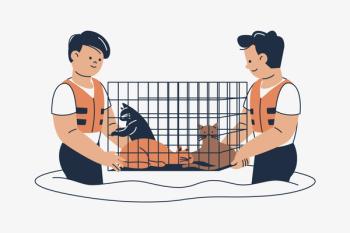
- dvm360 February 2022
- Volume 53
- Issue 2
Tooney’s Last Resort: An animal refuge
An animal hospital in New Jersey offers a haven for pets who require medical care their owners cannot manage or for animals who simply need a home.
Beach Animal Hospital in Point Pleasant Beach, New Jersey, is just like any other veterinary clinic, except 1 difference—it is filled with pets who have found a home within the building. This is because located on the practice’s premises is a not-for-profit animal sanctuary, Tooney’s Last Resort, that provides a temporary or long-term place of refuge for mostly cats, but also dogs, plus 1 chicken, and 1 bunny have found homes there since the refuge was founded in 1995.
In an
Why animals stay at Tooney’s Last Resort
Most animals find refuge at Tooney’s Last Resort because they require medical care for a condition—ranging from autoimmune disease to diabetes to kidney disease—that is more than their owner can manage financially or emotionally. However, once the animal hospital adopts the pet, they can provide them with proper care and treatment and offer them shelter. Other times, the sanctuary has taken in pets that simply need a home, whether they be those that an animal control officer couldn’t find an adopter for or those of a person who has gotten evicted, Himes used as examples.
Initially, the pets at Tooney’s Last Resort were housed in a garage near the animal hospital. However, because of the COVID-19 pandemic, that garage was converted into an area for owners to be with their pets during euthanasia. Ergo, the Tooney’s pets find solace and live amid all areas of the 4-story animal hospital.
“There’s a cat that prefers to live in the basement, and he has friends that come visit. There are cats that meander around the first floor, [and] there’s a couple cats that sleep in the waiting room chairs, regardless of who comes in,” Himes said. “A fair number of [the cats] live on the second floor, where the office is, and the lunchroom and the cat ward, and then a couple of them live upstairs in the attic.”
The origins and Tooney, “the benevolent ruler”
The origins of the philanthropy date back to before the animal hospital was even opened—during its renovation in the 90s. While working at a previous job, a client asked Himes whether she would adopt a cat from outside the trailer park where he was living. “[The client]…said, ‘Hey, they put a notice up, [and] they’re going to catch up all the cats and dispose of them.’ He said, ‘One of the [cats] I feed [is] real old and crotchety. He’ll never make it as an indoor cat. But this other cat, he’s really nice,’” Himes recounted.
Himes agreed to take in the friendly feline and thought Beach Animal Hospital would make a great home for him, so the client showed up to the veterinary clinic with a cat in an old-fashioned carrier. “[The client opened] the crate and this long, long, long cat [came] out. He just kept coming out of the carrier. He was like 19 lbs and fit,” she said. “I thought [the cat] was a girl at first, so his name was Petunia, but then he got bigger and bigger, and I realized he was a neutered male, so we named him Tooney.”
The rest was history. Tooney’s image became the logo, and he was the eponymous cat of the sanctuary. Himes described Tooney as the “benevolent ruler” of the clinic among the other felines who were taken in. “Other cats could start to fuss with each other, and [Tooney] would just give them a look and they’d settle right down,” she said. “It was great because you could have 20 cats roaming around the upstairs and no issues because [Tooney] just knew how to get along with everybody.”
Although Tooney passed away in 2008, the sanctuary was officially incorporated as a not-for-profit in 2009, when Himes decided to fundraise for and separate it from Beach Animal Hospital.
The future of Tooney’s Last Resort
Himes juggles between being a mother, running the animal hospital and seeing patients, and fundraising and doing paperwork for Tooney’s Last Resort. Although it’s hard to prioritize the animal sanctuary right now, she divulged that she sees herself dedicating more time to it in retirement so it can really take flight.
“We’re definitely going to keep [Tooney’s Last Resort] going. It’s sort of in a plateau phase right now, so we’ll see where it goes in the future. It might be something even bigger than what it’s been from before,” Himes said.
Articles in this issue
almost 4 years ago
Enter the 2022 dvm360® Hospital Design Competitionalmost 4 years ago
What’s new in 2022almost 4 years ago
Making room at the tablealmost 4 years ago
10 Dental hacks to enhance your veterinary practice in 2022almost 4 years ago
Do we need a paradigm shift in canine neutering?almost 4 years ago
Implementing virtual care in veterinary practicealmost 4 years ago
Commentary: compensating trainees as paid staffalmost 4 years ago
How research of an FIP treatment for cats is saving human livesalmost 4 years ago
At-home care is crucial to combating periodontal diseasealmost 4 years ago
The dilemma: approaching retirementNewsletter
From exam room tips to practice management insights, get trusted veterinary news delivered straight to your inbox—subscribe to dvm360.





